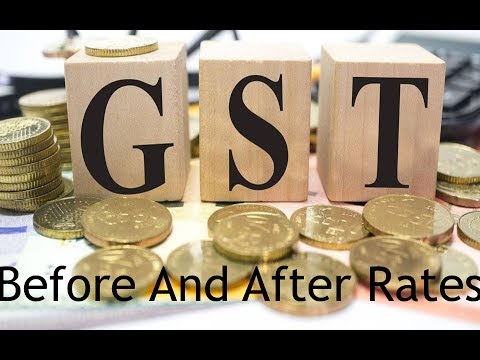Key Takeaways
- Unified Tax System: GST replaced multiple indirect taxes with a single, streamlined system, simplifying tax compliance and reducing administrative burdens.
- Reduced Cascading of Taxes: By enabling input tax credits, GST has eliminated the cascading effect of taxes, effectively lowering the cost of goods and services.
- Price Variability: GST has led to reduced prices for consumer goods and essential services, although some services have seen a slight increase due to higher tax rates.
- Increased Transparency: The GST regime has enhanced transparency and accountability in the tax system, fostering a more compliant business environment.
- Economic Efficiency: The elimination of inter-state barriers has improved supply chain efficiencies and reduced logistics costs, contributing to overall economic growth.
GST rates in India are designed to be dynamic and are categorized based on the necessity of goods and services. These rates are primarily divided into four slabs: 5%, 12%, 18%, and 28%. Additionally, some items like precious metals have a special rate, and essential goods such as fresh food are exempt from GST to avoid undue burden on the consumer.
Types of GST in India

- Central Goods and Services Tax (CGST)
Levied by the Central Government on intra-state (within the same state) sales of goods and services. The central government claims all CGST-collected revenue. The CGST rate is typically combined with the SGST rate to form the total GST rate applicable on an intra-state supply.
- State Goods and Services Tax (SGST)
Imposed by the respective state government on all transactions within a state. Like CGST, SGST is applicable to both goods and services sold within a single state. The revenue from SGST goes to the state government where the goods or services are sold.
- Integrated Goods and Services Tax (IGST)
Charged on the supply of goods and services from one state to another (inter-state). This is also applicable on imports. The IGST is levied by the central government but the revenue is shared between the state where the goods or services are consumed and the central government. IGST helps to ensure that the SGST component reaches the state where the goods or services are actually consumed.
- Union Territory Goods and Services Tax (UTGST)
Similar to SGST, but applied in Union Territories of India without their own legislatures. This includes regions like Andaman and Nicobar Islands, Lakshadweep, etc. UTGST and CGST are levied together on intra-union territory supply of goods and services.
GST Rate Structure
GST rates are divided into four primary slabs, which are applied based on the nature and necessity of the products or services:
- 5% Slab: This includes essential items such as household necessities and some services that are essential for daily use.
- 12% Slab: This includes goods and services that are regular but not considered essential. It bridges the gap between luxury and necessity.
- 18% Slab: The most common slab, covering the majority of goods and services, including those used by the middle class.
- 28% Slab: This is reserved for luxury items and certain demerit goods like tobacco, and luxury automobiles. This rate also includes a cess for certain products which can be higher than 28%.
The GST system is dynamic, with rates being revised based on economic needs and consumer feedback. Exemptions and special rates are also provided on some list of items like precious metals, making the structure complex but flexible to accommodate various economic scenarios.
GST Rates for Goods & services in India
| GST Rate | Goods | Services |
|---|---|---|
| 0% | Unprocessed food grains, fresh fruits and vegetables, milk, eggs, books, and newspapers | Education services, healthcare services |
| 5% | Packaged food items, coffee (except instant), tea, edible oils, sugar, life-saving drugs, coal | Transport services (railways, air transport of passengers with economy class), certain restaurants with turnover less than ₹1.5 crores, job work in textiles and apparel |
| 12% | Butter, cheese, ghee, mobile phones, Ayurvedic medicines, coloring books | Business class air travel, non-AC hotels, state-run lotteries, work contracts |
| 18% | Most consumer durables (e.g., washing machines, TVs), personal care items (soap, toothpaste) | Financial services, telecom services, IT services, AC hotels serving liquor, and most restaurant services |
| 28% | Luxury goods (automobiles, air-conditioners), sin products (tobacco, aerated drinks) | Luxury services (five-star hotels, race club betting), movie tickets |
HSN and SAC Coding Systems
In India, the implementation of the Goods and Services Tax (GST) introduced standardized systems for classifying goods and services to streamline the tax assessment process. These systems are known as the Harmonized System of Nomenclature (HSN) for goods and the Service Accounting Code (SAC) for services. Here’s an overview of both coding systems:

Harmonized System of Nomenclature (HSN)
The HSN code is a globally standardized system of names and numbers to classify traded products. More than 200 nations use it for consistent product classification in international trade, and the World Customs Organization (WCO) developed it. In the context of GST in India:
- Purpose: The HSN code helps in the systematic classification of goods under the GST regime, making it easier to levy the correct rate of GST on different products.
- Structure: HSN codes are made up of 6 digits. The first two digits represent the HSN chapter, the next two digits denote the heading number, and the last two digits indicate the product code. In India, depending on the business turnover, entities might need to use a 4-digit code, 6-digit code, or an 8-digit code. The 8-digit code provides the most precise classification, used mainly for compliance and statistical purposes.
- Application: All traders are required to use the HSN code on their invoices. Small businesses with an annual turnover of less than ₹1.5 crores are not required to use the code, while those with a turnover between ₹1.5 crores and ₹5 crores use a 2-digit code, and those with a turnover exceeding ₹5 crores use a 4-digit code.
Service Accounting Code (SAC)
The SAC system is used to classify services under the GST regime. It is similar to the international Harmonized System of Nomenclature that India and many other countries use for goods.
- Purpose: SAC allows for the systematic categorization of all services, ensuring each is taxed under the correct GST slab and simplifying the process of compiling accounting and tax returns.
- Structure: The SAC is a six-digit number. The first two digits are fixed for all services (99), which is the code designated for services. The next two digits represent the major nature of services, and the last two digits signify the detailed nature of services.
- Application: SAC codes must be mentioned in invoices and GST returns by all service providers, making it an essential part of tax compliance.
GST Rates on products before and after GST
The Goods and Services Tax (GST) applies to a wide range of common items, affecting everything from daily necessities to luxury goods. This tax aims to streamline the complex inverted tax structure, making it easier for businesses and consumers to manage their finances. Here, we explore the current GST rates on some common items, which vary depending on the nature and necessity of the products.
- Electric Vehicles (EVs)
GST Rate: 5%
Reason: To promote the use of environmentally friendly electric vehicles, the GST on these items has been reduced from a higher rate to encourage adoption.
- Human Consumption
Food Products: Essential food items like grains, pulses, and flour that are not branded or packed attract a 0% GST rate. Processed foods generally fall under higher slabs of 5%, 12%, or 18%, depending on the level of processing and the ingredients used.
- Hair Oil
GST Rate: 18%
Context: As a personal care item, hair oil is placed under the 18% tax bracket, which is the standard rate for most personal care products.
- Excise Duty
Note: With the introduction of GST, most of the excise duties were subsumed under GST. Specific products like petroleum and alcohol for human consumption still attract excise duty in addition to GST.
- Current GST Rates
Categories: From zero-rated essentials to luxury goods at 28%, GST rates are structured to ensure that essential items are affordable while luxury items contribute more to the tax system.
- Applicable Rates for Gear Boxes
GST Rate: 28%
Details: Being part of automotive components and machinery, gearboxes are taxed at the highest GST slab due to their non-essential nature.
- Joy Rides
GST Rate: 18% or 28%
Explanation: Depending on the type of amusement parks and the nature of the service, joy rides can be taxed at either 18% or the highest slab of 28%.
- Compensation Cess
Additional Charge: Some luxury items and demerit goods also attract a GST compensation cess over and above the GST rate, which is intended to compensate states for any revenue loss due to the implementation of GST.
- Raw Materials
Typical Rates: Vary greatly, but raw materials used in manufacturing that aren’t finished products themselves generally attract a lower GST rate, to avoid cost buildup as products move through production stages.
- Mining Lease Holders
GST Rate: 5%
Purpose: Reduced rate to support mining activities, which are critical for the economy but require significant upfront investment.
- Theme Parks
GST Rate: 18% or 28%
It depends on: The classification of the service provided; basic entertainment services attract 18%, whereas more extensive, luxury-oriented services attract 28%.
Benefits of GST

- Simplified Tax Structure
Before the introduction of GST, India had a complicated tax system with multiple taxes levied by the state and federal governments, including VAT, service tax, and excise. With GST, these have been consolidated into a single tax system, reducing the multiplicity of taxes and making compliance easier for businesses.
- Elimination of Cascading Tax Effects
GST is a destination-based tax where the tax is collected by the state where goods are consumed. It allows for credit of input tax (ITC) across the supply chain from production to consumption, eliminating the cascading effect of taxes, where taxes were previously paid on already taxed amounts.
- Increased Transparency and Efficiency
GST has brought in more transparency by minimizing direct human interaction in tax procedures through the digitalization of processes. Online procedures for registration, returns, refunds, and compliance reduce complexity and increase efficiency.
- Boost to the Economy
By creating a unified national market, GST reduces the cost of goods and services, stimulating demand and economic growth. It also enhances the export competitiveness of Indian goods and services in the global market.
- Enhanced Compliance
With the GST system, the number of compliances is lower, and the entire process from registration to filing returns is done online through the GST portal. This ease of doing business encourages better tax compliance from businesses.
- Input Tax Credit Mechanism
The ITC mechanism under GST prevents the tax-on-tax scenario and can be claimed at each stage of the supply chain. This feature significantly reduces the overall cost of production and distribution, leading to reduced prices for consumers.
- Regulation of the Unorganized Sector
Specific provisions under GST, such as the reverse charge mechanism (RCM), e-way bills, and compliance ratings, incentivize tax compliance by unorganized and semi-organized sectors, bringing transparency and accountability.
GST Council’s Proactive Role
The GST Council plays a crucial role in reviewing and revising GST laws and rates, ensuring that they remain industry-friendly and consumer-friendly. Regular GST council meetings help address any immediate issues faced by businesses or consumers.
- Flexibility to Introduce Multiple Rate Structures
GST accommodates multiple rate slabs to categorize different items under various GST tax rate slabs, which range from 0% to 28%. This flexibility helps in taxing essential items at lower rates and luxury items at higher rates, maintaining economic balance.
- Sector-Specific Benefits
Different sectors like manufacturing, FMCG, and input services have seen specific benefits from GST, including smoother interstate movement of goods, reduction in logistics costs, and removal of small border taxes.
GST Council and Its Importance
The GST Council is an apex member committee that decides on various issues related to the GST system in India. The council, which has the Union Finance Minister of India as its chair, consists of the finance ministers of all the states and union territories with legislatures. This structure is instrumental in ensuring a collaborative approach to tax governance, which is critical in a federal structure like India.
Key Responsibilities of the GST Council
- Rate Revisions
The GST Council is responsible for revising GST rates periodically. This includes increasing or decreasing the rates based on macroeconomic trends, inflation, and other economic factors that necessitate such changes.
- GST Rate Slabs
The council decides on the categorization of goods and services into different GST rate slabs. Currently, there are four primary GST rate slabs: 5%, 12%, 18%, and 28%. Special rates exist for precious items like gold and rough precious stones, as determined by the council.
- Rules and Regulations
The GST Council regularly reviews and implements amendments to GST laws and bylaws. This ensures that the GST remains a dynamic tax system responsive to the economic needs and compliance capabilities of taxpayers.
- GST Exemptions and Inclusions
Deciding which goods and services are to be exempt from GST is one of the critical functions of the GST Council. This impacts a variety of sectors and helps make essential goods and services more affordable to the general public.
- Input Tax Credit and Reverse Charge Mechanism
The council has a significant say in the policies regarding Input Tax Credit (ITC) adjustments and the conditions under which the reverse charge mechanism is to be applied. These decisions affect the cash flow and tax liability of businesses across sectors.
Special Provisions for States and Sectors
The GST Council addresses particular needs by offering special provisions or relaxations to states or sectors that might suffer from the standard GST policies, taking into account the diverse economic landscapes of Indian states.
Impact of GST Council Decisions
- Business Compliance: By simplifying and clarifying tax structures, the council’s decisions help businesses understand their tax obligations better, leading to improved compliance.
- Consumer Prices: Decisions made by the GST Council directly influence the prices of goods and services in the market, affecting inflation and the cost of living.
- Economic Growth: Through its policymaking, the GST Council facilitates a conducive environment for economic growth by ensuring fair competition and removing economic barriers.
Impact of GST on Prices: Before and After

- Consumer Goods
Before GST: Consumer goods were subject to multiple taxes, including VAT, excise, and other state levies, which often resulted in a higher cumulative tax rate.
After GST: Most consumer goods have seen a reduction in tax burden under the unified GST slabs (5%, 12%, 18%, and 28%). Essentials and daily needs often fall into the lower slabs, reducing their price, while luxury goods are taxed at a higher rate.
- Services
Before GST: Services were taxed at a standard rate of 15% under Service Tax.
After GST: which taxes services at various rates but typically at 18%, has taken the place of service tax. While this has led to a slight increase in costs for some services, the input tax credit availability has helped businesses offset these costs over time.
- Electronics
Before GST: The tax rate on electronics could go up to 25-30% with excise duty and VAT combined.
After GST: Electronics are generally placed under the 18% GST slab, which in many cases has brought down the prices, making electronics more affordable to the general population.
- Automobiles
Before GST: Automobiles attracted high excise duty (up to 27%), along with VAT and other taxes which could make the overall tax rate exceed 40%.
After GST: Most automobiles are now taxed at a base rate of 28% plus a variable cess, which for many vehicles has reduced the overall tax burden, although luxury vehicles have seen an increase due to the higher cess.
- Real Estate
Before GST: The construction of apartments dealt with complexity due to the presence of multiple taxes including VAT, service tax, and excise.
After GST: Real estate has been subjected to a 12% GST rate with full input tax credit, which has the potential to reduce costs, though the actual impact varies based on the state and the type of property.
- Food and Restaurants
Before GST: Dining out could attract VAT plus service tax, cumulatively reaching up to 20-25%.
After GST: Restaurants are charged under different GST slabs based on whether they are air-conditioned or not. Rates on hotel accommodation are taxed at 12%, and on AC restaurants at 18%, potentially reducing the tax burden on eating out, except in luxury dining scenarios.
Broader Economic Impact
The broader impact of GST on prices has also been influenced by improved supply chain efficiencies and reduced logistics costs, thanks to the elimination of interstate check posts and smoother movement of goods. While the initial rollout of GST saw some price volatility as markets adjusted to the new system, the overall trend has moved towards price stabilization and increased transparency in taxation.
Conclusion
The GST has transformed the Indian tax structure, making it more methodical and growth-oriented. While there are obstacles, the general trend shows a favorable transition toward a more responsible and broad-based tax system.
💡For seamless GST payments and managing your export bills efficiently, consider using the PICE application. Get started with PICE today and streamline your GST payments and export invoicing process. Click here to sign up and take the first step towards hassle-free GST management.
FAQs
What is the highest GST rate applied in India?
In India, the highest GST rate is 28%, which is predominantly applied to luxury goods such as high-end motor vehicles, aerated drinks, and certain appliances. This rate is intended to ensure that luxury consumption contributes more significantly to the nation’s revenue.
Are there any items exempt from GST?
Yes, there are numerous items exempt from GST to minimize the financial burden on essential services and goods. These exemptions include unprocessed food staples, fresh fruits and vegetables, milk, educational services, and healthcare services, which are critical for everyday living.
How does GST benefit the common man?
GST benefits the common man by reducing the overall tax burden, which results from the removal of the cascading effect of taxes where tax was previously levied upon tax. This system simplifies understanding and compliance, leading to lower prices for various goods and services.
What is the role of the GST Council?
The GST Council plays a critical role in the GST system as it determines the tax rates, exemptions, and inclusions under the GST regime. It comprises state and union territory finance ministers and the Union Finance Minister of India, ensuring a balanced approach to fiscal policymaking across the country.
How has GST impacted small businesses?
GST has significantly impacted small businesses by simplifying the tax filing process through the Composition Scheme, which allows small businesses to pay GST at a nominal rate of their turnover. This scheme simplifies the GST process and reduces the tax burden, making compliance easier and more affordable for small business owners.








